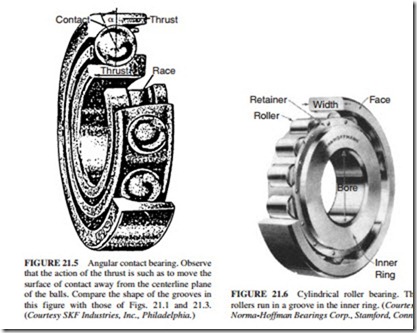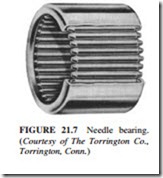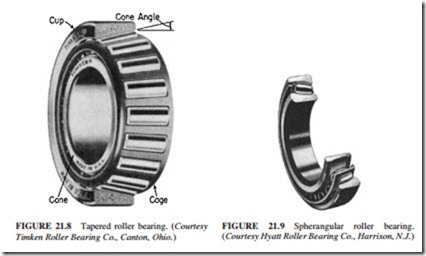TYPES OF ROLLER BEARINGS
Figure 21.1 has illustrated the deep-groove ball bearing. Figure 21.3 illustrates a filling- slot type of ball bearing. The slots or notches permit the assembly of more balls, giving the bearing larger radial load capacity. Both bearings are used for radial loads only.
Figure 21.4 illustrates a self-aligning ball bearing. It compensates for angular misalignments that arise from the deflection of the shaft or foundation or from errors in mounting. They are recommended for radial loads and moderate thrust in either direction.
Figure 21.5 illustrates an angular-contact bearing. There is an angle between the line through the areas carrying the load and the plane of the bearing face. These bearings are used to carry heavy thrust loads. They are usually used in opposed pairs. They are also suited for preloading. Preloading a bearing involves placing it under an initial axial load which is independent of the working load to maintain a constant alignment of parts and reducing the axial movement as well as radial deflection under working loads.
Double-row ball bearings (not self-aligning) are similar to the single-row ball bearings. The only difference is that each ring has two grooves. The two rows of balls give a bearing capacity slightly less than twice that of a single-row type.
Figure 21.6 illustrates a cylindrical roller bearing. The contact is a line instead of a point, as is the case in ball bearings. This results in a greater area to carry the load. Hence,
for a particular size, the cylindrical roller bearing has a larger radial capacity than a ball bearing. The main function of the retainer is to keep the roller axes parallel.
A popular type of cylindrical roller bearing is the needle bearing shown in Fig. 21.7. This type does not have a retainer to hold the rollers in alignment. Their main advantage is the small diametral dimension. They are used where the speed is relatively low and where there is oscillating motion.
rolling elements are arranged as frustums of a cone. All their axes intersect at a point on the axis of the shaft. These bearings are capable of carrying significant axial loads.
Figure 21.9 illustrates a “spherangular” roller bearing. This is an angular contact bear- ing with rollers instead of balls. The bearing is self-aligning because the outer race has a spherical surface. It has also a high load capacity due to its large contact area.
THRUST BEARINGS
The rolling type of thrust bearings uses the following as rolling elements: balls, short cylindrical rollers, tapered rollers, and spherical rollers that run in spherical races (self- aligning). These bearings can be rigidly supported, or one of the races can be supported in a spherical seat to make it self-aligning. Figures 21.10 and 21.11 illustrate thrust bear- ings that use balls and tapered rollers as rolling elements, respectively.


